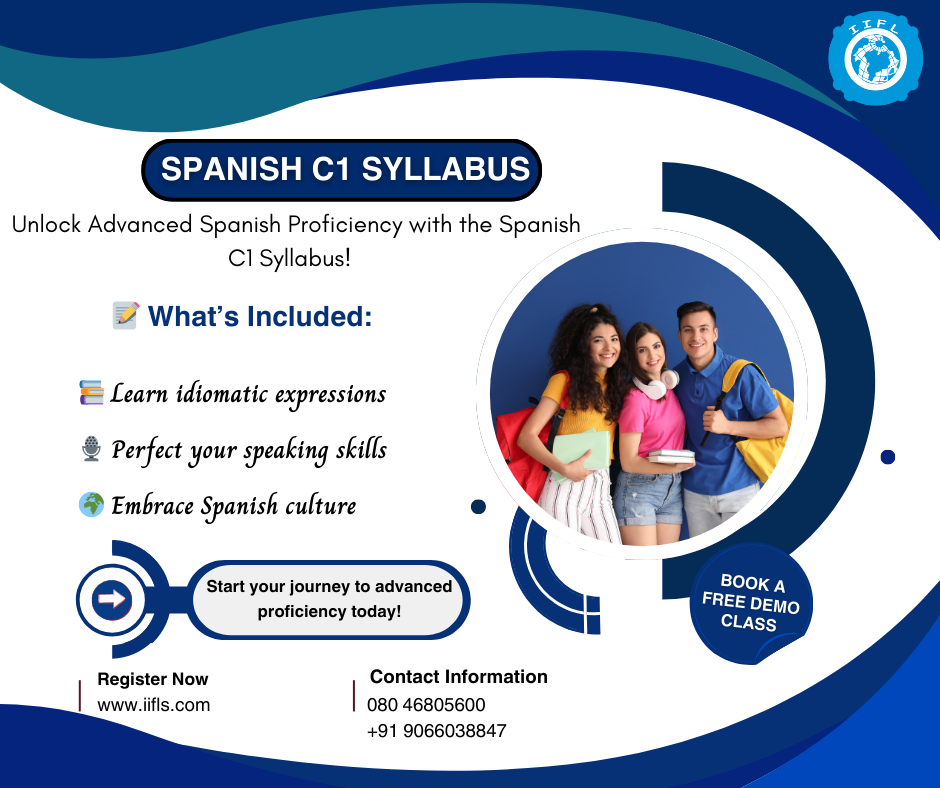Spanish C1 Syllabus – Achieve Advanced Spanish Proficiency
What is the C1 Level in Spanish? : The C1 level in Spanish is classified as advanced proficiency according to the Common European Framework of Reference for Languages (CEFR). At this stage, learners can express themselves fluently, understand complex texts, and engage in professional and academic discussions with ease.
Reaching a C1 level in Spanish is a significant milestone that showcases advanced proficiency in the language. Whether for academic, professional, or personal goals, mastering this level involves a deep understanding of Spanish grammar, vocabulary, and cultural nuances. This article outlines a comprehensive Spanish C1 syllabus, providing the necessary tools and guidance to excel.

Introduction to Spanish C1 Proficiency
The C1 level, as defined by the Common European Framework of Reference for Languages (CEFR), is characterized by the ability to use the language effectively and fluently in a wide range of contexts. At this stage, learners can comprehend complex texts, express ideas fluently without much searching for expressions, and use language flexibly for academic, professional, and social purposes.
Key Components of the Spanish C1 Syllabus
The Spanish C1 syllabus focuses on mastering advanced grammar, expanding vocabulary, and enhancing comprehension and communication skills. Learners refine their use of complex tenses, subjunctive moods, and intricate sentence structures. The Spanish C1 syllabus emphasizes building a sophisticated vocabulary, including idiomatic expressions and professional terminology, to enable nuanced conversations. It also includes analyzing diverse texts and practicing formal writing such as essays and reports. Listening to native speakers and developing speaking fluency are essential elements. By following the Spanish C1 syllabus, students achieve a deeper understanding of cultural nuances, making the Spanish C1 syllabus vital for advanced proficiency.
1. Advanced Listening Comprehension (Comprensión Auditiva de Nivel Superior)
Listening Skills as explained in Spanish C1 course details
The Spanish C1 course details emphasize advanced listening skills to understand native speakers in various contexts. Students engage with authentic materials like podcasts, radio broadcasts, and live discussions to develop comprehension. The Spanish C1 course details highlight recognizing regional accents, colloquialisms, and intonation patterns to interpret emotions and subtle meanings. Training includes analyzing speeches and debates for structure and rhetorical techniques. As per the Spanish C1 course details, learners practice active listening to extract key points and infer implied ideas. This immersive approach ensures the Spanish C1 course details equip students with the tools needed for fluent and nuanced understanding.
Understanding Native Speakers
- Training with podcasts, radio broadcasts, and debates.
- Picking up on regional accents and colloquialisms.
Key Techniques
- Focusing on intonation and stress patterns to interpret emotions and intentions.
A C1 Spanish learner can:
- Understand extended and complex speech, even when spoken quickly or in regional accents.
- Follow specialized discussions, academic lectures, and professional presentations without difficulty.
- Grasp implied meanings, sarcasm, and cultural references in spoken Spanish.
2. High-Level Reading Skills (Lectura Crítica y Analítica)
Reading Comprehension
Diverse Text Types
- Analyzing academic articles, editorials, and literature for deeper comprehension.
- Extracting key ideas, arguments, and opinions from complex texts.
Techniques for Analysis
- Identifying tone, style, and purpose in writings.
- Recognizing implied meanings and cultural references.
At C1 proficiency, students are able to:
- Analyze opinion pieces, academic papers, and literary texts with depth.
- Interpret figurative language, idiomatic expressions, and rhetorical devices in advanced readings.
- Summarize and critically evaluate complex arguments and abstract concepts.
3. Fluent and Spontaneous Speaking (Expresión Oral con Precisión y Matices)
Speaking Proficiency
Fluency in Conversations
- Engaging in discussions on abstract topics like philosophy, politics, and art.
- Debating and defending viewpoints eloquently.
Presentation Skills
- Delivering structured speeches with persuasive arguments.
- Using rhetorical devices effectively.
A C1 Spanish speaker can:
- Communicate effectively in formal and informal settings with precision.
- Present detailed arguments and counterarguments in debates or discussions.
- Use cultural references, humor, and persuasive language naturally.
4. Structured and Cohesive Writing (Redacción Compleja y Argumentativa)
Advanced Writing Skills
Formal Writing
- Crafting essays, reports, and proposals with clarity and cohesion.
- Employing advanced connectors like sin embargo, por lo tanto, and en consecuencia.
Creative Writing
- Writing narratives and personal reflections using varied vocabulary.
- Experimenting with styles to match purpose and audience.
C1 learners enhance their writing by:
- Producing well-structured essays, reports, and professional documents.
- Using advanced linking devices and cohesive strategies for logical flow.
- Adapting writing tone and style for different audiences and contexts.
Essential Grammar Structures in the Spanish C1 Syllabus
Advanced Grammar Mastery
At the C1 level, grammar becomes more nuanced. Here are the essential areas to focus on:
Subjunctive Mastery
- Complex use of present, past, and imperfect subjunctive in both formal and informal settings.
- Understanding nuances in expressing doubts, wishes, and hypothetical scenarios.
Compound Tenses
- Mastery of perfect tenses, including pretérito perfecto compuesto and pretérito pluscuamperfecto.
- Usage of future and conditional perfect tenses for hypothetical and speculative discussions.
Advanced Sentence Structures
- Mastery of relative clauses using pronouns like cuyo, el cual, and lo que.
- Use of impersonal expressions to add formality and complexity, e.g., Es imprescindible que… or Se dice que….
To refine grammatical accuracy, learners focus on:
- Advanced Subjunctive Uses – Expressing doubt, probability, and hypothetical situations.
- Formal and Academic Language Structures – Mastering impersonal expressions and nominalization.
- Nuanced Use of Modal Verbs – Conveying obligation, probability, and speculation.
- Idiomatic Constructions & Complex Sentence Patterns – Enhancing fluency and sophistication.
Expanding Vocabulary for Diverse Contexts
Expanding Vocabulary
Academic and Professional Vocabulary
- Incorporating field-specific terms for professional communication.
- Focus on idiomatic expressions and colloquialisms for a more authentic sound.
Cultural and Historical Terms
- Understanding cultural nuances through vocabulary related to Spanish traditions, festivals, and literature.
Collocations and Synonyms
- Learning synonyms and context-specific word collocations for enhanced fluency.
The Spanish C1 syllabus introduces specialized vocabulary in:
- Philosophy & Abstract Thinking – Expressing deep opinions and ethical considerations.
- Legal & Political Discourse – Understanding policies, rights, and global affairs.
- Scientific & Technical Language – Discussing research, data analysis, and innovations.
- Cultural and Artistic Expression – Analyzing literature, film, and creative works.
How to Prepare for the Spanish C1 Exam?
To succeed in a C1-level Spanish proficiency test, learners should:
- Engage with academic and professional Spanish media, such as research papers and documentaries.
- Participate in intellectual discussions with native speakers or in forums.
- Write persuasive essays and analytical reports to practice structure and coherence.
- Listen to advanced podcasts, debates, and TED Talks to sharpen comprehension.
Spanish B2 syllabus
Tips for Achieving Spanish C1 Proficiency
Achieving Spanish C1 Proficiency requires dedication and strategic learning. Immerse yourself in the language by engaging with native speakers and consuming Spanish media like films, podcasts, and books. Regularly practice speaking to enhance fluency and confidence. Focus on mastering advanced grammar and expanding your vocabulary with idiomatic expressions and specialized terms. Structured courses or one-on-one tutoring can accelerate your progress toward Spanish C1 Proficiency by addressing specific weaknesses. Utilize apps and online resources to practice daily. Consistent effort and exposure to diverse materials will ensure you achieve Spanish C1 Proficiency and maintain it effectively. Embrace the journey to Spanish C1 Proficiency!
Spanish B1 syllabus
- Immerse Yourself
- Spend time in Spanish-speaking countries or engage with native speakers regularly.
- Watch films, read books, and participate in cultural events.
- Practice Consistently
- Dedicate daily time for structured study and real-life practice.
- Join language exchange programs or online Spanish forums.
- Seek Professional Guidance
- Enroll in advanced Spanish courses designed for C1 learners.
- Work with native-speaking tutors to refine pronunciation and usage.
- Use Technology
- Leverage language-learning apps that offer advanced exercises.
- Participate in webinars or virtual language workshops.
Benefits of Attaining C1 Fluency in Spanish
Reaching a C1 Spanish level enables learners to:
- Communicate with near-native fluency in social, professional, and academic settings.
- Understand highly complex texts and spoken discourse with ease.
- Pursue career opportunities or higher education in Spanish-speaking environments.
Final Thoughts
The Spanish C1 syllabus serves as a roadmap to advanced Spanish proficiency, equipping learners with the skills needed for academic, professional, and social success. By mastering complex grammar, expanding vocabulary, and honing listening, speaking, reading, and writing abilities, students develop confidence in using the language effectively in diverse situations. This syllabus also emphasizes cultural awareness, enabling a deeper connection with Spanish-speaking communities. Through consistent practice and immersion, learners can achieve fluency and express themselves with sophistication. Following the Spanish C1 syllabus ensures a comprehensive approach to mastering the language and unlocking new personal and professional opportunities.
Spanish A2 syllabus
Important FAQ’S
- What is the Spanish C1 syllabus?
The Spanish C1 syllabus is a comprehensive guide outlining the skills, grammar, vocabulary, and topics learners must master to achieve advanced proficiency in Spanish.
- What does the Spanish C1 syllabus cover?
It covers advanced grammar, expansive vocabulary, listening and speaking skills, writing techniques, reading comprehension, and cultural understanding.
- Is Spanish C1 equivalent to fluency?
While not native-level fluency, Spanish C1 proficiency enables learners to use the language flexibly and effectively in professional, academic, and social settings.
- What are the key grammar topics in the Spanish C1 course content?
Topics include advanced subjunctive moods, compound tenses, complex sentence structures, and nuanced use of relative clauses.
- How much vocabulary is needed for C1 Spanish?
The syllabus emphasizes mastering around 10,000 words, including idiomatic expressions, formal terms, and specialized vocabulary.
- What types of texts are studied at C1 level?
Learners analyze academic articles, editorials, literary works, and technical documents.
- What listening skills are developed in the Spanish C1 level?
Students focus on understanding native speakers, regional accents, colloquialisms, and implied meanings.
- What kind of writing skills does the syllabus emphasize?
It focuses on formal writing like essays and reports, as well as creative writing styles and structured narratives.
- How is speaking proficiency addressed in the syllabus?
Emphasis is placed on debates, presentations, and conversations on abstract or complex topics.
- What is the role of cultural understanding in the Spanish C1 course details ?
Cultural knowledge enhances context comprehension, especially for idioms, traditions, and regional language variations.
- How does the Spanish C1 course content differ from lower levels?
It dives deeper into advanced grammar and emphasizes fluency, precision, and understanding of nuanced contexts.
- How long does it take to complete the Spanish C1 course content ?
On average, it takes 800–1,000 hours of total study time to reach C1 proficiency from beginner levels.
- Can I achieve Spanish C1 proficiency through self-study?
Yes, but combining self-study with structured courses and interaction with native speakers is more effective.
- Are there exams for Spanish C1 proficiency?
Yes, DELE C1 (Diploma de Español como Lengua Extranjera) is a common certification exam for C1 level.
- What role does immersion play in the Spanish C1 course details?
Immersion is crucial for real-world application and improves fluency by exposing learners to natural language use.
- What resources are best for mastering the Spanish C1 level syllabus?
Use advanced textbooks, online courses, language apps, podcasts, and literature in Spanish.
- How is listening assessed in the Spanish C1 course content?
Assessments often include interpreting conversations, identifying key points, and understanding implied meanings.
- What role do idiomatic expressions play in the syllabus?
They are essential for sounding natural and understanding native-level communication.
- How are writing skills evaluated in the Spanish C1 course content?
Learners are assessed on coherence, advanced grammar use, vocabulary variety, and formal tone in their writing.




